How to live? We all have to find our own answer to that question, but part of the enjoyment of the journey is looking at how others deal with it.
The sixteenth century French writer Michel de Montaigne is an interesting case. Withdrawing from public life to his estate near Bordeaux at the age of 38 he decided to dedicate to his life to trying to answer that question through a series of self-soundings which he published as the Essais. A lot of the early essais are quite dry and often repeat what his favourite classical writers had to say. Frequently that was contradictory. But when he starts to explore his own reactions to the world, gaining in self-confidence as he begins to trust his own views over those of the ancients, he becomes much more interesting
He lived in very turbulent times in France during the Wars of Religion, when Catholic and Protestant factions fought each other often viciously and the crown, buffeted by both factions, was powerless to exert its authority. Montaigne was Catholic and hated the turmoil in society that religion had caused, but his estate was in the middle of a Protestant area.
So, I’m on another literary pilgrimage to visit the château of this writer who has been a bit of a hero of mine for over 40 years.
The estate, in the village of St Michel de Montaigne just north of the Dordogne, is still there today and so is the Tower that housed his library where he studied and wrote his Essais. The original château was built by his grandfather in the fifteenth century as a fortified Périgord house rather than a castle, and it stayed in his family until 1811 when it was bought by M Magne, Minister of Finance under Napoleon III. He had the house re-built as a fantasy Gothic Loire valley château, with turrets and steep, slate roofs, completely out of keeping with the original house and the architecture of Périgord. Only Montaigne’s Tower and the sixteenth century outbuildings which housed a laundry, stables and wine storehouse were retained.
The Gothic monstrosity burnt down in 1885 (apart from Montaigne’s Tower and the outbuildings), but M Magne’s daughter, convincingly demonstrating that bad taste is inherited, had it re-built to the same design. The château is today still in the hands of the Magne family.
Between the outer gate and the inner courtyard, protected by stout gates, was a barbican which could be defended against intruders from a parapet high above.
Montaigne’s wife, who had the best business head in the partnership and mainly managed the estate, had her own tower at the other end of the rampart, but this no longer exists. The château itself was Montaigne’s mother’s domain. So you have the sense of these three people each having their own space.
It was in the late eighteenth / early nineteenth century that the Tower started to become a site of literary pilgrimage. Until then the Tower had rather fallen into a state of disrepair, with the lower story (which Montaigne’s father, Pierre, turned into a chapel) used as a potato store. Curiously the chapel is built in a sort of Byzantine style. It has a blue ceiling sprinkled with white stars and the inner wall has trompe-l’oeil niches in it surmounted by the coats of arms of family and friends. Montaigne, whose bedroom is on the floor above, used to say that he slept above the sky. It’s so dark that photography is virtually impossible, so apologies for the next shot, but I wanted to give a sense of what it looks like:
The main focus of the chapel is the simple niche altar with a now faded painting of St Michael killing a dragon.
M Magne did not like the painting because it was so faded and had it replaced by a canvas reproducing the same painting but in more vibrant colours: this thankfully has now been removed.
Over the entrance to the chapel on the inside is Montaigne’s own device, a lion’s paw on a black background with golden trefoils (symbolising wealth) surrounded by shells (symbolising nobility). Also over the entrance is an aperture through which Montaigne could hear Mass being said from his bedroom on the floor above. During the worst of the Wars of religion when many churches were closed, Montaigne got permission from the Protestant Henri de Navarre (and future Henri IV) for Mass to be said daily in his chapel.
The bedroom, with its original tiled floor and wooden ceiling, contains a four-poster bed which is not contemporary. Our guide tells us that in Montaigne’s time people slept sitting up, supported by pillows and covered with blankets, since they were frightened of dying in their sleep if they lay down. I’m not convinced of this explanation and have not read it anywhere else.
When Montaigne lived here there were no glass windows: window spaces were covered with hanging cloths, so rooms were cold and draughty. To the side of one of the two windows is a recess where Montaigne sat to read and keep warm.
 The chimney breast over the fireplace is decorated with paintings, now so badly faded it is impossible to make them out. They were done by a painter from Italy whom Montaigne commissioned to illustrate scenes from his favourite book, Ovid’s Metamorphoses. Many of these paintings here and in other parts of the Tower were whitewashed over by Montaigne’s descendants and by the ever tasteful M Magne.
The chimney breast over the fireplace is decorated with paintings, now so badly faded it is impossible to make them out. They were done by a painter from Italy whom Montaigne commissioned to illustrate scenes from his favourite book, Ovid’s Metamorphoses. Many of these paintings here and in other parts of the Tower were whitewashed over by Montaigne’s descendants and by the ever tasteful M Magne.
 In the early 1580s Montaigne set off on a trip to Italy with his secretary, servants and assorted young male relatives. The experience was captured in a travel journal that he kept which was only discovered nearly 200 years later in a metal chest in the château. The chest now stands in the corner of the bedroom beneath a bust of the writer. Actually the travel journal turned out to be a rather dry affair kept by his clerk in the third person, with none of the vivacity of the better essais.
In the early 1580s Montaigne set off on a trip to Italy with his secretary, servants and assorted young male relatives. The experience was captured in a travel journal that he kept which was only discovered nearly 200 years later in a metal chest in the château. The chest now stands in the corner of the bedroom beneath a bust of the writer. Actually the travel journal turned out to be a rather dry affair kept by his clerk in the third person, with none of the vivacity of the better essais.
Montaigne’s library and workroom occupies the top floor of the Tower. The entrance door is quite low, a reminder not just that medieval people were generally shorter than modern people, but also that Montaigne was a small man, probably no more than 1.5m tall. He complains about his stature in the Essais: being taken for one of his servants sometimes when out on business and preferring to move about on horseback rather than on foot to avoid being jostled by other people in the street.
The main item in the library is a desk and chair – again not original. Montaigne preferred to dictate his essais to a clerk sitting at a desk, as he found it hard to think while sitting down.
From the windows on the top floor he had a commanding view of the estate and good give orders and instructions to the estate workers. As he walked around the Tower he could see above him painted on the beams favourite quotes (mainly in Latin, but some in Greek) from his favourite Classical writers;
Also as he walked, thought and dictated he would stop and consult his books to check a quote or story. The books and the shelves they stood on are unfortunately no longer there. In his will he left his books to Marie de Gournay, his fille d’alliance (‘adopted daughter’, though celebrity stalker might be more accurate) but, before she could get to the château after his death, his wife had given all his books away to friends. There’s a whole sub-genre of Montaigne studies which is concerned with tracking down his library and studying the marginalia. For its time it was a considerable library of about 1,000 books, housed on 5 shelves between the two windows facing the writing desk.
An artist’s impression on the easel shows what the bookshelves may have looked like:
Behind the writing desk is a plaque to his friend Etienne de la Boétie who died of the plague in his early thirties. Montaigne was at his bedside when he died and recalled his friend’s model Stoic approach to death. In part the Essais is a continuation of the friendship and conversation which Montaigne enjoyed with la Boétie for a mere six years.
A half-size (and not particularly well done) statue of Montaigne executed in the 1960s stands in the library today.
Originally there was a fireplace here, but Montaigne had it bricked up as he was afraid that a fire might destroy his books. So to keep warm in the coldest weather, Montaigne and his clerk would withdraw to a side room, the cabinet de travail, where there was a fireplace.
It was very richly decorated with now faded paintings, though some of the designs and vibrant colours are still visible.
High up on one of the walls is a plaque in Latin that Montaigne had made when he made the decision to retire to his estate.
Here’s my translation:
In the year of Christ 1571, at the age of 38 years, on the eve of the calends of March [ie the last day of February], the anniversary of his birth, Michel de Montaigne, bored for a long time by his bondage at the Court of Parliament [in Bordeaux, where he served as an officer preparing case summaries for the magistrates] and by his public duties, still feeling full of energy, came to rest on the bosom of the learned virgins [ie the Muses] in calm and serenity; he will spend there the remaining days of his life.
Hoping that fate will allow him to complete this dwelling of sweet paternal retreats, he has dedicated them to his freedom, tranquillity and leisure.
Over the chimney breast is a Roman Pieta, based on the story of the daughter who, visiting her condemned father in prison, offers him her breast to suckle. The father’s captor, seeing this gesture, was so moved that he freed the father. Apart from the prison grill it is very difficult to see any of the detail.
At the top of the Tower there used to be a clock which deafeningly sounded the hours in Montaigne’s time, but at some stage after his death it came crashing down damaging the staircase.
Appropriately for this writer who never shied away from the earthier side of what it is to be human, a long-drop loo stands off to one side f the newel staircase between the 2nd and 3rd floors. More poignantly, it must have been a place of torment too as Montaigne suffered agonising bouts of kidney stone lasting several days which left him exhausted, but curiously clear-headed too.
The visit leaves me with a great sense of his character still filling this place where he lived, thought and wrote about what it is to be human, and in particular, what it was like to be Michel de Montaigne.
On the way out I buy a bottle of the wine still produced on the estate and was disappointed that the small shop did not have a copy of the Quesnel drawing of Montaigne made in 1588 just four years before he died.

Montaigne by Quesnel
It is considered to be one of the most lifelike pictures of him. He looks like a warm, friendly and wise person – exactly the way he comes across in the Essais.


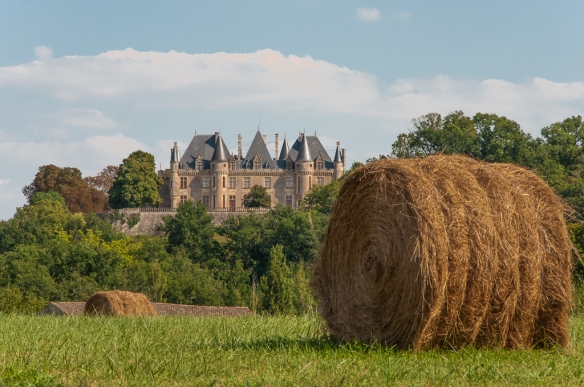



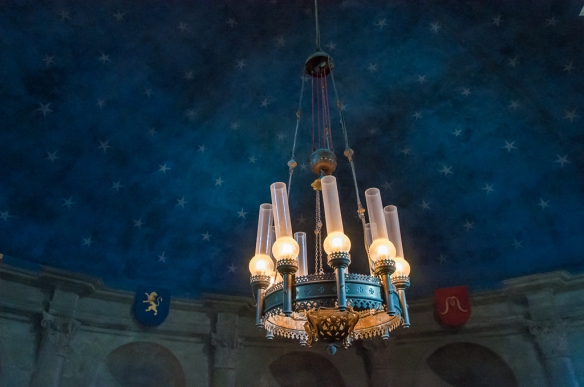




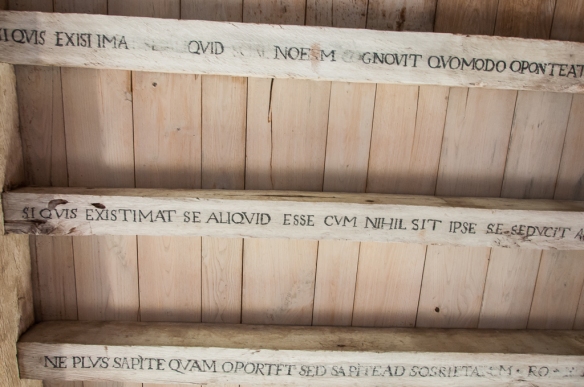
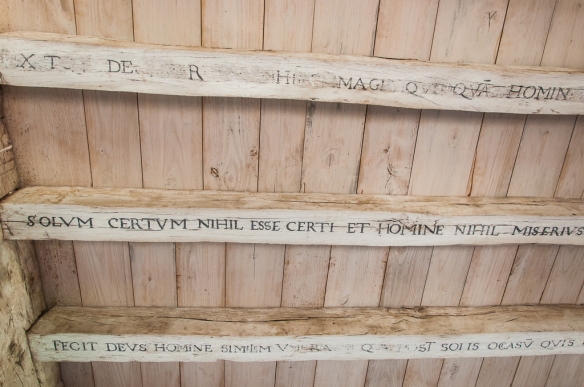

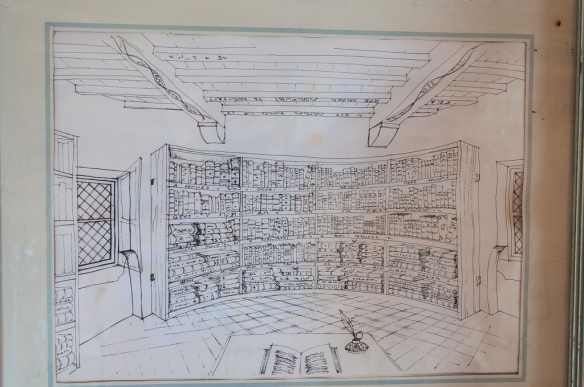








Thank you for the insight into Montaigne’s living quarters, quite fascinating.
Hi Malcolm,
Thanks for reading the post and glad you enjoyed it.
Peter
This is really great – Thanks
Reblogged this on Sarah Bakewell and commented:
Thank you very much to Greg Lennes for alerting me to this beautiful photographic post of a visit to Montaigne’s tower. And of course thank you even more to its author.
Hello Peter – I liked your photographs so much that I linked to this using WordPress’s reblog feature, which makes it appear on my site. I’ve done everything WordPress allows to make it super-clear it’s not my own, but please do let me know if you object to how it looks, and I’ll remove it or add a different kind of link. Meanwhile, thanks for the beautiful post – really enjoyed it! Sarah
Hi Sarah,
Thank you very much for your kind words. I’m delighted that you liked my pictures and no objection at all to being re-blogged. I’m very flattered in fact!
I loved your book on Montaigne – easily the best book on him in my view – and have read it twice now, the second time in France during the summer when we visited the Tower.
He’s not an easy writer to write well about, but your writing is so clear, precise and a great pleasure to read. It was a great idea to tackle the subject in the form of questions. There are so many bits of your book I liked, but one which stays with me particularly is your evocation of what life on M’s estate sounded like in the sixteenth century. To me the past is mute, like the eery silence of old black and white photographs, so it was stimulating to read your imaginative recreation of that sound world.
Did you spend much time at the Tower when your were doing your research? I was delighted to see that your book is on prominent display in the appropriately amateurish little shop.
Thank you very much for the enjoyment your book has given me.
Best wishes,
Peter
Thank YOU for your extremely kind words, Peter! Yes, I spent a long wintry afternoon there – out of season so no one else around, and easier to listen to the ghost sounds. I was surprised how easy it was to imagine 400-odd years falling away. Though impossible to tell whether the imaginings are just a 21st-century fantasy. A few glasses of the Chateau wine seem to help..
Pingback: Review of 2013 posts | wordscene
Your photo essays are elegant and extraordinary. Thank you so much for this one on Montaigne’s tower. The library shots are powerful … I can now imagine him in his tower, writing and reading. Thank you for the closeup of the imagined view of the bookshelves. Was the “Que sais Je?” plaque in sight?
Hi Sharon,
What a coincidence! I was about to contact you on your blog http://proustmatters.com/ which I only came across recently on the Proust Yahoo list.
Thank you for your kind words and so pleased you enjoyed my Montaigne visit post. I have just gone back through all my shots and can’t find one of the plaque you mention. I suspect it may be one of the two terracotta coloured plaques on the wall behind the chair. The other one is, I think, about La Boetie.
I was about to contact you about your great post ‘The Bookends of the Search Contain a Secret’ (http://proustmatters.com/2014/08/13/post-bookends-of-the-search/) which is a fantastic find. I wanted to ask if I could link to it on my blog and also add you to my blog roll. I have often wondered why there are no explicit mentions of Montaigne in ALRTP. Proust must have known the Essais: how could it not have been a favourite read?
Your post made me think about whether there are other more implicit links to Montaigne and I was drawn back to the essai called On Practice (II,6) where Montaigne describes an accident which left him in a semi-conscious state. I have had a quick re-read (very little time at the moment for anything else) but can’t find any obvious verbal echoes in Proust. I’ll have to go back to it when I have more time. There’s something about it though that makes me think there is a connection. This episode in Montaigne’s life was the one that helped him overcome his fear of death. Maybe it’s just the similarity of the experience of the hypnagogic state.
I am really looking forward to making my way through all of your posts. Incidentally, you might also like my post about a visit to Illiers-Combray over 40 years ago: https://wordscene.wordpress.com/2012/11/18/du-cote-de-chez-proust-a-literary-pilgrimage/
Many thanks for contacting me.
Peter
Dear Peter,
I would be honored to be linked and blogged to your beautiful and insightful site – that’s praise for both your Words and Images. Can’t wait to view your visit to Illiers-Combray.
Sharon
Pingback: Post – Bookends of the Search | wordscene
Hi Peter, a great photo essay. Or should I say essai. What do I know.
Due to an unexpected illness in the family, I didn’t make it to Montaigne’s Chateau on a planned holiday to Perigord last year. Now I’ve stumbled on a wonderful source of imagery and description. I’m developing a fiction novel based on some events on Montaigne’s life although he is not the main character. If you are agreeable, I would like to add a reference to this page in the acknowledgments/further reading on the basis of its conjuring into reality what my words will likely fail to do!
I’m plowing through Saul Frampton’s knowledgeable book on Montaigne for further background
I agree that Sarah Bakewell’s How to Live is great. She really brings his thinking to life and is hard to beat for simple pleasure and contemporary resonance.
kind regards, Paul
Hi Paul,
Thanks for your kind words. Sorry to hear that you weren’t able to get to Perigord, hope that you manage to get there at some point in the future.
I would be very happy for you acknowledge my post in your novel. What will it be about? Look forward to reading it!
Kind regards,
Peter
Hi Peter,
thanks very much. I’ve added a reference in the right Scrivener location (such a good app for writing).
Hard to answer what’s it about – a road trip, a quest, a love story, a history of a forgotten sect. It was a febrile period for religious strife and the original Game of Thrones (poisonings, assassinations, violence). But what is an awkward bookish young man to do when his parents are carted off by the French Inquisition and suspicion of heresy falls on him?
Hi Paul,
Thanks. Sounds like an interesting idea for a novel. Could you let me know when it’s available?
Peter
Many thanks for spending time making this public. I began my journey with M.M. in late 2012 and he has been such a steadfast companion. These pictures really give me a grasp for the man.
Hi Wes,
Thanks for the feedback. He is a companion for life!
Peter
I loved Sarah Bakewell’s book, and found your website through hers – great photo-essay!! Makes me want to visit Montaigne’s tower with my son. I’ve never traveled in Europe though, and wondered if you had any good websites or recommendations for travel info? The ones I found via Google were confusing.
Hi Salisha,
Thanks for your comments. I don’t know where you’re travelling from and where you want to visit in Europe, so hard to advise.
Trip Advisor is a very good source of info on places to stay and eat, but pre-supposes that you know where you want to go and usually how you will get there.
Alternatively you could get some travel advice from a travel agent in your own country.
Kind regards,
Peter
Pingback: Montaigne – El club Pickwick
Pingback: Creative Blogging – Auxiliary Memory
Pingback: Poor Man’s Time Machine – Auxiliary Memory
I love this philosopher over all how his dad raised him, sending him to the Village to learn from people and also when dad used to wake him up with music every morning
Thank you for this wonderful post and for the photos. I have a much better sense of the Tower.
Do you find it ironic that Montaigne ensconced himself in a tower from which he could see out over his estate, in order to explore the interior world of his own mind?
Thank you for your kind words. I am pleased that the post has given you a better sense of Montaigne’s physical context.
I can see that initially he needed to isolate himself to really understand what he really thought, as opposed to what his education and reading taught him that he ought to think. As he does this he questions what he thinks and has taken as read up to that point. So he becomes much more ambivalent about Christianity and his personal beliefs: the Religious Wars showed him the dangers of a dogmatic approach Ultimately he comes to what seems to me to be an almost Buddhist approach and acceptance of what is.
Fantastic post. Thank you